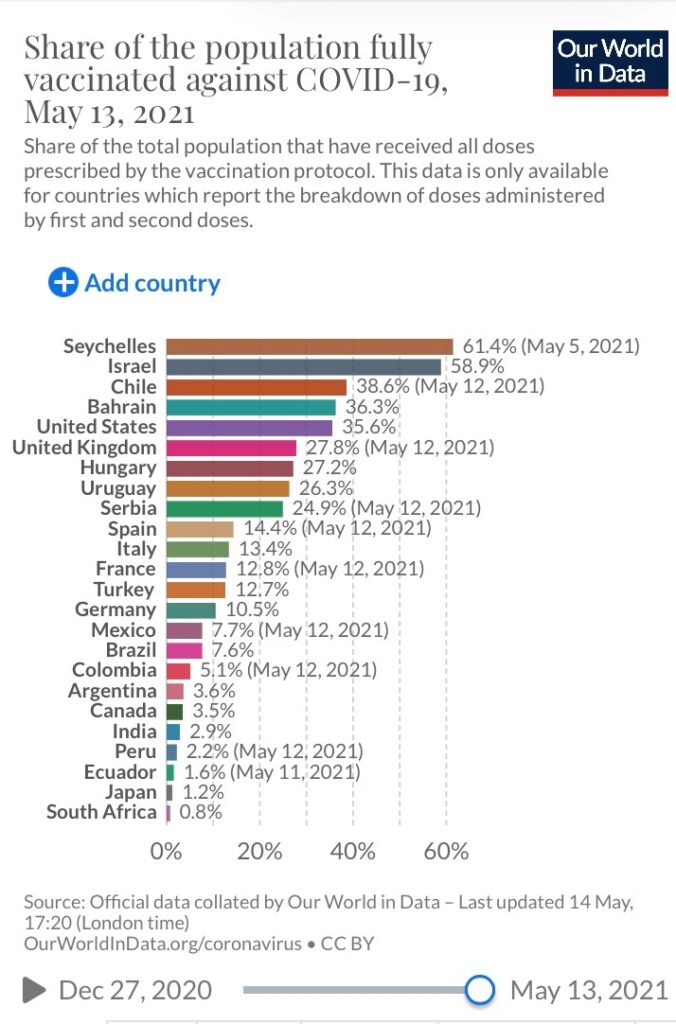A. Many countries are doing better than before, but most still lag really far behind countries like Israel, the UK, and the US.
Increasing global coverage of vaccinations will be key to getting COVID-19 under control not just outside the US, but even inside the US. As a recap of our previous posts on this topic, there are both epidemiological and economic reasons to expand coverage of safe and effective vaccines around the world:
➡️ EPIDEMIOLOGICAL: The virus doesn’t adhere to national boundaries. Allowing the virus to circulate unchecked provides a breeding ground for the emergence of variants that can bypass the immunological defenses provided by existing vaccines. The best way to stop the spread of COVID-19 and to prevent new variants is to vaccinate as many people as quickly as possible all over the world. The US is doing a much better job of vaccinating its residents, but a “return to normal” may be short-lived if newer variants resistant to current vaccines are given an opportunity to emerge elsewhere.
➡️ ECONOMIC: A recent study on the global economic consequences of failing to vaccinate people in countries all over the world found that allowing COVID-19 to rage in poorer countries is likely to have bad economic consequences for industries in high-income countries that depend on global supply chains. These industries include automotive, textiles, construction, and retail. So even as we progress to a greater sense of normality in the US, there’s a high risk of some serious sticker shock for Americans (and low supply) for goods that would normally be lower priced and widely available.
❓ What countries have made gains?
In our first post on global vaccine updates in Feb, Israel, the United Arab Emirates, and the UK were leading the way in vaccinating their respective populations. At the other end of the spectrum, a majority of the countries in Latin America and Africa had not administered a single dose. Now in mid-May, not only has the US made substantial gains, but so have countries like Chile and Uruguay, and many European countries. Seychelles, an archipelago of islands in the Indian Ocean, holds the title for “the most vaccinated nation” in the world.
That’s the good news.
The bad news? According to the WHO, lower-income countries, which represent 47% of the world’s population, have received just 17% of the world’s vaccines. Meanwhile, higher-income countries have received more than 80% of the world’s vaccines.
OTHER UPDATES:
💥 Last week, the US announced its support for temporarily removing patent protections for COVID-19 vaccines as a way to increase global vaccine production and boost supply. But this move was met with strong opposition by vaccine manufacturers and several European countries. Discussions are ongoing.
💉 The vaccine from the Chinese company Sinopharm has been approved for emergency use by the WHO, which allows it to be included in COVAX, the global sharing program which aims to supply vaccines to poorer countries.
But questions still linger about the safety and efficacy of the vaccine, especially for the prevention of symptomatic illness and infection, since no Phase 3 trial data have been published yet.
Sinopharm was also put under closer scrutiny this week when it was revealed that, despite its status as the most vaccinated country in the world, Seychelles has been experiencing an alarming COVID-19 surge, including among residents fully vaccinated with Sinopharm, but also AstraZeneca. One promising aspect is that the surge among vaccinated people has not been accompanied by hospitalizations and deaths in this group. This means that the vaccines are doing their job to prevent serious illness. But it does raise questions about whether these vaccines can be effective for containing outbreaks more generally.
CONCLUSION:
There are still huge disparities in access to safe and effective vaccines all around the world. As noted by WHO head Dr. Tedros Adhanom Ghebreysus, this “shocking global disparity remains one of the biggest risks to ending the pandemic.” Even for countries like the US where a return to normal appears to be on the horizon, what happens outside the US could have serious implications for our ability to sustain a return to normal.
LINKS:
Our World in Data Global Vaccination Stats
Study of economic consequences of pandemic (National Bureau of Economic Research)
US backs waiver of COVID-19 vaccine patents
Previous post on safety and efficacy of Sinopharm and other vaccines used outside the US




